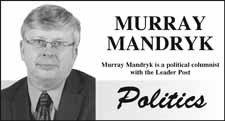It must frustrate rural people to no end to hear the NDP Opposition bemoan the state of health care under Premier Brad Wall's government.
Now, don't get me wrong. Saskatchewan Party government health care coverage is something less than perfect. In fact, certain elements may be downright wrong-headed.
The first problem is that we likely haven't seen enough structural change - at least when it comes to the key elements that drive up health care costs.
For starters, for all the fussing and fuming over the Essential Services Legislation that was deemed by the courts to be an infringement on the Charter of Rights and Freedoms, the health sector hasn't exactly done horribly under the Sask. Party government when it comes to wage increases.
This is because one of the first orders of business of the new Saskatchewan Party government back in 2008 was to give the Saskatchewan Union of Nurses a 35-per-cent, four-year increase. The decision set off a round of health care inflation (other health care unions thought it appropriate to demand excessive increases, as well) evident in provincial budgets since. More than 70 per cent of our $4.6-billion health budget goes to wages.
Similarly, the Sask Party government has a penchant for building hospitals and nursing homes (not to mention the pending new Children's Hospital in Saskatoon).
Nor has the Sask. Party government really done much to eliminate unnecessary and costly bureaucracy - whether it be in the health ministry, the costly Saskatchewan Association of Health Organizations that negotiates with the unions or the health districts themselves that swallow up precious dollars on administration that could go to frontline care.
Given these on-going and massive structural problems, attempts to save money through "lean" efficiencies may seem a drop in the bucket. In fact, NDP Opposition noted in the assembly last week that $1.4 million has been spent on efficiency consultants whose work has alleged produced six dollars saved for every dollar spent. (This, by the way, is the same ratio that the film industry says went back to the Saskatchewan economy from the provincial tax credit.)
But while the NDP Opposition might be rather smug about the foibles of Sask. Party government health delivery, they seem to be forgetting a few important points.
First, all of the above - including inflation-driving wage increases - happened under NDP governments, as well. If anything, the Sask. Party government in the last two budgets may be finally getting a handle on health care inflation. The NDP and health "experts" may take great delight in mocking the government for thinking the health system can be run like a Japanese auto plant. But those little savings like $10 million no longer wasted on spoiled blood seem to be helping.
Second, while costs did go up under NDP administration, waiting lists also grew. For all the squawking on hears from NDP ranks about the evils of private surgical centres, it appears they are making progress on reducing wait times.
Third _ and perhaps most significant from rural Saskatchewan's vantage - is that we are no longer seeing the closure of 52 rural hospitals. (By contrast, we're seeing this government replace 13 aging hospitals and nursing homes in rural Saskatchewan and replace major facilities in North Battleford and Moose Jaw.)
Sure, one can accurately say NDP government cuts in the early 1990s were necessary because of the Progressive Conservative debt. One can further argue Wall has lucked into good economic times and a health system already made leaner.
However, rural Saskatchewan also now sees a government less obsessed with the principles of public health delivery and more interested in actual service delivery.
And this reality makes the NDP criticism of Wall government health care a little hard to take.
Murray Mandryk has been covering provincial politics for over 15 years.




